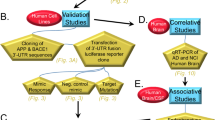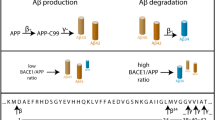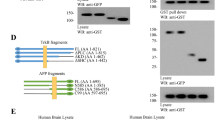Abstract
In Alzheimer disease, increased β-secretase (BACE1) activity has been associated with neurodegeneration and accumulation of amyloid precursor protein (APP) products. Thus, inactivation of BACE1 could be important in the treatment of Alzheimer disease. In this study, we found that lowering BACE1 levels using lentiviral vectors expressing siRNAs targeting BACE1 reduced amyloid production and the neurodegenerative and behavioral deficits in APP transgenic mice, a model of Alzheimer disease. Our results suggest that lentiviral vector delivery of BACE1 siRNA can specifically reduce the cleavage of APP and neurodegeneration in vivo and indicate that this approach could have potential therapeutic value for treatment of Alzheimer disease.
This is a preview of subscription content, access via your institution
Access options
Subscribe to this journal
Receive 12 print issues and online access
$209.00 per year
only $17.42 per issue
Buy this article
- Purchase on Springer Link
- Instant access to full article PDF
Prices may be subject to local taxes which are calculated during checkout






Similar content being viewed by others
Accession codes
References
Sinha, S. et al. Recent advances in the understanding of the processing of APP to beta amyloid peptide. Ann. NY Acad. Sci. 920, 206–208 (2000).
Kamenetz, F. et al. APP processing and synaptic function. Neuron 37, 925–937 (2003).
Selkoe, D.J. & Schenk, D. Alzheimer's disease: Molecular understanding predicts amyloid-based therapeutics. Annu. Rev. Pharmacol. Toxicol. 43, 545–584 (2003).
Citron, M. Emerging Alzheimer's disease therapies: inhibition of β-secretase. Neurobiol. Aging 23, 1017–1022 (2002).
Sinha, S. et al. Purification and cloning of amyloid precursor protein beta-secretase from human brain. Nature 402, 537–540 (1999).
Esler, W.P. & Wolfe, M.S. A portrait of Alzheimer secretases–new features and familiar faces. Science 293, 1449–1454 (2001).
Selkoe, D. et al. Beta-amyloid precursor protein of Alzheimer disease occurs as 110- to 135-kilodalton membrane-associated proteins in neural and nonneural tissue. Proc. Natl. Acad. Sci. USA 85, 7341–7345 (1988).
Selkoe, D.J. et al. The role of APP processing and trafficking pathways in the formation of amyloid beta-protein. Ann. NY Acad. Sci. 777, 57–64 (1996).
Dingwall, C. Spotlight on BACE: the secretases as targets for treatment in Alzheimer disease. J. Clin. Invest. 108, 1243–1246 (2001).
Shen, J. et al. Skeletal and CNS deficits in Presenilin-1–deficient mice. Cell 89, 629–639 (1997).
Roberds, S.L. et al. BACE knockout mice are healthy despite lacking the primary beta-secretase activity in brain: implications for Alzheimer's disease therapeutics. Hum. Mol. Genet. 10, 1317–1324 (2001).
Ohno, M. et al. BACE1 deficiency rescues memory deficits and cholinergic dysfunction in a mouse model of alzheimer's disease. Neuron 41, 27–33 (2004).
Li, R. et al. Amyloid beta peptide load is correlated with increased beta-secretase activity in sporadic Alzheimer's disease patients. Proc. Natl. Acad. Sci. USA 101, 3632–3637 (2004).
Holsinger, R.M., McLean, C.A., Beyreuther, K., Masters, C.L. & Evin, G. Increased expression of the amyloid precursor beta-secretase in Alzheimer's disease. Ann. Neurol. 51, 783–786 (2002).
Fukumoto, H., Cheung, B.S., Hyman, B.T. & Irizarry, M.C. Beta-secretase protein and activity are increased in the neocortex in Alzheimer disease. Arch. Neurol. 59, 1381–1389 (2002).
Vassar, R. The beta-secretase, BACE: a prime drug target for Alzheimer's disease. J. Mol. Neurosci. 17, 157–170 (2001).
Hong, L. et al. Structure of the protease domain of memapsin 2 (beta-secretase) complexed with inhibitor. Science 290, 150–153 (2000).
Miller, V.M., Gouvion, C.M., Davidson, B.L. & Paulson, H.L. Targeting Alzheimer's disease genes with RNA interference: an efficient strategy for silencing mutant alleles. Nucleic Acids Res. 32, 661–668 (2004).
Tiscornia, G., Singer, O., Ikawa, M. & Verma, I.M. A general method for gene knockdown in mice by using lentiviral vectors expressing small interfering RNA. Proc. Natl. Acad. Sci. USA 100, 1844–1848 (2003).
Naldini, L. et al. In vivo gene delivery and stable transduction of nondividing cells by a lentiviral vector. Science 272, 263–267 (1996).
Tuszynski, M.H. Gene therapy for neurological disease. Expert Opin. Biol. Ther. 3, 815–828 (2003).
Marr, R.A. et al. Neprilysin gene transfer reduces human amyloid pathology in transgenic mice. J. Neurosci. 23, 1992–1996 (2003).
Davidson, B.L. & Paulson, H.L. Molecular medicine for the brain: silencing of disease genes with RNA interference. Lancet Neurol. 3, 145–149 (2004).
Kao, S.C., Krichevsky, A.M., Kosik, K.S. & Tsai, L.H. BACE1 suppression by RNA interference in primary cortical neurons. J. Biol. Chem. 279, 1942–1949 (2004).
Takahashi, R.H. et al. Oligomerization of Alzheimer's beta-amyloid within processes and synapses of cultured neurons and brain. J. Neurosci. 24, 3592–3599 (2004).
Kayed, R. et al. Common structure of soluble amyloid oligomers implies common mechanism of pathogenesis. Science 300, 486–489 (2003).
Lacor, P.N. et al. Synaptic targeting by Alzheimer's-related amyloid beta oligomers. J. Neurosci. 24, 10191–10200 (2004).
Walsh, D.M. et al. Naturally secreted oligomers of amyloid beta protein potently inhibit hippocampal long-term potentiation in vivo. Nature 416, 535–539 (2002).
Kim, H.S. et al. Carboxyl-terminal fragment of Alzheimer's APP destabilizes calcium homeostasis and renders neuronal cells vulnerable to excitotoxicity. FASEB J. 14, 1508–1517 (2000).
Song, D.K. et al. Behavioral and neuropathologic changes induced by central injection of carboxyl-terminal fragment of beta-amyloid precursor protein in mice. J. Neurochem. 71, 875–878 (1998).
Oster-Granite, M., McPhie, D., Greenan, J. & Neve, R. Age-dependent neuronal and synaptic degradation in mice transgenic for the C terminus of the amyloid procursor protein. J. Neurosci. 16, 6732–6741 (1996).
Berger-Sweeney, J. et al. Impairments in learning and memory accompanied by neurodegeneration in mice transgenic for the carboxyl-terminus of the amyloid precursor protein. Brain Res. Mol. Brain Res. 66, 150–162 (1999).
Kim, H.S., Park, C.H. & Suh, Y.H. C-terminal fragment of amyloid precursor protein inhibits calcium uptake into rat brain microsomes by Mg2+-Ca2+ ATPase. Neuroreport 9, 3875–3879 (1998).
Xia, H. et al. RNAi suppresses polyglutamine-induced neurodegeneration in a model of spinocerebellar ataxia. Nat. Med. 10, 816–820 (2004).
Huse, J.T. et al. Beta-secretase processing in the trans-Golgi network preferentially generates truncated amyloid species that accumulate in Alzheimer's disease brain. J. Biol. Chem. 277, 16278–16284 (2002).
Rossner, S., Apelt, J., Schliebs, R., Perez-Polo, J.R. & Bigl, V. Neuronal and glial beta-secretase (BACE) protein expression in transgenic Tg2576 mice with amyloid plaque pathology. J. Neurosci. Res. 64, 437–446 (2001).
Kitazume, S. et al. Alzheimer's beta-secretase, beta-site amyloid precursor protein-cleaving enzyme, is responsible for cleavage secretion of a Golgi-resident sialyltransferase. Proc. Natl. Acad. Sci. USA 98, 13554–13559 (2001).
Kitazume, S. et al. In vivo cleavage of alpha2,6-sialyltransferase by Alzheimer beta-secretase. J. Biol. Chem. 280, 8589–8595 (2005).
Wong, H.K. et al. Beta subunits of voltage-gated sodium channels are novel substrates of BACE1 and gamma-secretase. J. Biol. Chem. 280, 23009–23017 (2005).
Chang, W.P. et al. In vivo inhibition of Abeta production by memapsin 2 (beta-secretase) inhibitors. J. Neurochem. 89, 1409–1416 (2004).
Brummelkamp, T.R., Bernards, R. & Agami, R. A system for stable expression of short interfering RNAs in mammalian cells. Science 296, 550–553 (2002).
Naldini, L., Blomer, U., Gage, F.H., Trono, D. & Verma, I.M. Efficient transfer, integration, and sustained long-term expression of the transgene in adult rat brains injected with a lentiviral vector. Proc. Natl. Acad. Sci. USA 93, 11382–11388 (1996).
Pfeifer, A., Kessler, T., Silletti, S., Cheresh, D.A. & Verma, I.M. Suppression of angiogenesis by lentiviral delivery of PEX, a noncatalytic fragment of matrix metalloproteinase 2. Proc. Natl. Acad. Sci. USA 97, 12227–12232 (2000).
Mucke, L. et al. High-level neuronal expression of Aβ 1–42 in wild-type human amyloid protein precursor transgenic mice: synaptotoxicity without plaque formation. J. Neurosci. 20, 4050–4058 (2000).
Masliah, E. et al. Aβ1–42 promotes cholinergic sprouting in patients with Alzheimer disease and Lewy body variant of Alzheimer disease. Neurology 61, 206–211 (2003).
Masliah, E. et al. Dopaminergic loss and inclusion body formation in alpha-synuclein mice: Implications for neurodegenerative disorders. Science 287, 1265–1269 (2000).
Rockenstein, E. et al. High beta-secretase activity elicits neurodegeneration in transgenic mice despite reductions in amyloid-beta levels: implications for the treatment of Alzheimer's disease. J. Biol. Chem., published online 15 July 2005 (10.1074/jbc.M507016200).
Rockenstein, E., Mallory, M., Mante, M., Sisk, A. & Masliah, E. Early formation of mature amyloid-b proteins deposits in a mutant APP transgenic model depends on levels of Ab1–42. J. Neurosci. Res. 66, 573–582 (2001).
Rockenstein, E. et al. The neuroprotective effects of Cerebrolysin in a transgenic model of Alzheimer's disease are associated with improved behavioral performance. J. Neural Transm. 110, 1313–1327 (2003).
Acknowledgements
This work was supported by US National Institutes of Health grants AG5131, AG10435, AG18440 and AG08514 to F.H.G. R.A.M. was supported in part by fund from the Canadian Institutes of Health Research.
Author information
Authors and Affiliations
Corresponding authors
Ethics declarations
Competing interests
The authors declare no competing financial interests.
Rights and permissions
About this article
Cite this article
Singer, O., Marr, R., Rockenstein, E. et al. Targeting BACE1 with siRNAs ameliorates Alzheimer disease neuropathology in a transgenic model. Nat Neurosci 8, 1343–1349 (2005). https://doi.org/10.1038/nn1531
Received:
Accepted:
Published:
Issue Date:
DOI: https://doi.org/10.1038/nn1531
This article is cited by
-
Pathophysiological Aspects and Therapeutic Armamentarium of Alzheimer’s Disease: Recent Trends and Future Development
Cellular and Molecular Neurobiology (2023)
-
Nanomaterials for neurodegenerative diseases: Molecular mechanisms guided design and applications
Nano Research (2022)
-
The effect of BACE1-AS on β-amyloid generation by regulating BACE1 mRNA expression
BMC Molecular Biology (2019)
-
Delivery of BACE1 siRNA mediated by TARBP-BTP fusion protein reduces β-amyloid deposits in a transgenic mouse model of Alzheimer’s disease
Journal of Biosciences (2019)
-
Recent advances in the design and applications of amyloid-β peptide aggregation inhibitors for Alzheimer’s disease therapy
Biophysical Reviews (2019)



